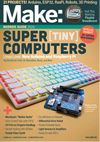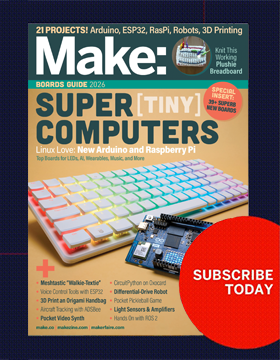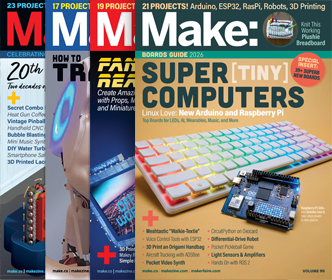
Colorful Comic Kaleidoscope
WHAT WILL YOU MAKE?
Make a kaleidoscope to bathe a black and white Spider-Man comic in colorful light. Ordinary kaleidoscopes need ambient light to work: you view it by pointing it toward a light source. This one has built-in illumination so you can hold it right up against a printed page. The special RGB LED has a color-changing feature that continuously cycles through a rainbow of colors, making viewing black and white comics a trippy treat!
Download Spider-Man comic here.
WHAT WILL YOU LEARN?
You will learn to construct an LED lit kaleidoscope
STEPS
STEP 1
STEP 2
Solder the LED's flat-side lead to ground of a 3V button cell battery holder and solder the other leg to one of the contacts on the switch. Solder the other switch contact to the positive on the battery. Insert the battery into the holder, then flip the switch to turn on the LED and watch it cycle through its colors!
STEP 3
Make a small hole for the switch on the side of the tube. Position the disc, LED side down, on top and slip the battery into the space between an ABS strip and the tube. Slide the switch through the hole. If needed, cover the back and side of the LED with a small piece of black electrical tape to shade your eye from glare.
WHAT'S NEXT?
Once you’ve bathed the black and white Spider-Man comic in the dazzling colors from your kaleidoscope, try adding two LEDs to see the new light effects. Will you try red and blue for Spider-Man colors, and yellow and green for one of his archenemies? You could also make two kaleidoscopes, one with each color combo, so you can play out a battle between the two in colorful lights!
Download Spider-Man comic here.
Materials:
- Paper towel tube
- Scrap foam
- Black ABS plastic sheet, enough for three strips, about 6" √ó 8"
- Tricolor RGB LED
- SPST switch
- Hook-up wire
- CR2032 3V button cell battery
- Battery clip for button cell
- Compass
- Hobby knife
- Solder iron and solder
- 3/4" and 1/16" drill bit and drill
- Download Spider-Man comic here.
- Super glue
- Electrical tape
See More Projects in these topics:
Arts & Crafts ElectronicsSee More Projects from these themes:
Art/Craft StudioMaker Camp
Please Note
Your safety is your own responsibility, including proper use of equipment and safety gear, and determining whether you have adequate skill and experience. Power tools, electricity, and other resources used for these projects are dangerous, unless used properly and with adequate precautions, including safety gear and adult supervision. Some illustrative photos do not depict safety precautions or equipment, in order to show the project steps more clearly. Use of the instructions and suggestions found in Maker Camp is at your own risk. Make Community, LLC, disclaims all responsibility for any resulting damage, injury, or expense.
Maker Camp Project Standards
Based on NGSS (Next Generation Science Standards)
National Core Arts Standards
The National Core Arts Standards are a process that guides educators in providing a unified quality arts education for students in Pre-K through high school. These standards provide goals for Dance, Media Arts, Music, Theatre, and Visual Arts with cross-cutting anchors in Creating, Performing, Responding, and Connecting through art. The Anchor Standards include:- Generate and conceptualize artistic ideas and work.
- Organize and develop artistic ideas and work.
- Refine and complete artistic work.
- Select, analyze, and interpret artistic work for presentation.
- Develop and refine artistic techniques and work for presentation.
- Convey meaning through the presentation of artistic work.
- Perceive and analyze artistic work.
- Interpret intent and meaning in artistic work.
- Apply criteria to evaluate artistic work.
- Synthesize and relate knowledge and personal experiences to make art.
- Relate artistic ideas and works with societal, cultural, and historical context to deepen understanding.
NGSS (Next Generation Science Standards)
The Next Generation Science Standards (NGSS) are K–12 science content standards. Learn more.Forces and Motion
- 3-PS2-3. Ask questions to determine cause and effect relationships of electric or magnetic interactions between two objects not in contact with each other.
- HS-PS4-5. Communicate technical information about how some technological devices use the principles of wave behavior and wave interactions with matter to transmit and capture information and energy.
NGSS MS.Engineering Design
The Next Generation Science Standards (NGSS) are K–12 science content standards.- MS-ETS1-1. Define the criteria and constraints of a design problem with sufficient precision to ensure a successful solution, taking into account relevant scientific principles and potential impacts on people and the natural environment that may limit possible solutions.
- MS-ETS1-2. Evaluate competing design solutions using a systematic process to determine how well they meet the criteria and constraints of the problem.
- MS-ETS1-3. Analyze data from tests to determine similarities and differences among several design solutions to identify the best characteristics of each that can be combined into a new solution to better meet the criteria for success.
- MS-ETS1-4. Develop a model to generate data for iterative testing and modification of a proposed object, tool, or process such that an optimal design can be achieved.
NGSS HS.Engineering Design
The Next Generation Science Standards (NGSS) are K–12 science content standards.- HS-ETS1-1. Analyze a major global challenge to specify qualitative and quantitative criteria and constraints for solutions that account for societal needs and wants.
- HS-ETS1-2. Design a solution to a complex real-world problem by breaking it down into smaller, more manageable problems that can be solved through engineering.
- HS-ETS1-3. Evaluate a solution to a complex real-world problem based on prioritized criteria and trade-offs that account for a range of constraints, including cost, safety, reliability, and aesthetics as well as possible social, cultural, and environmental impacts.
- HS-ETS1-4. Use a computer simulation to model the impact of proposed solutions to a complex real-world problem with numerous criteria and constraints on interactions within and between systems relevant to the problem.
ALL DONE? SHARE IT!
Share pictures and videos of your cool build! Be sure to use #maketogether or #makercamp
POST YOUR PROJECTS


